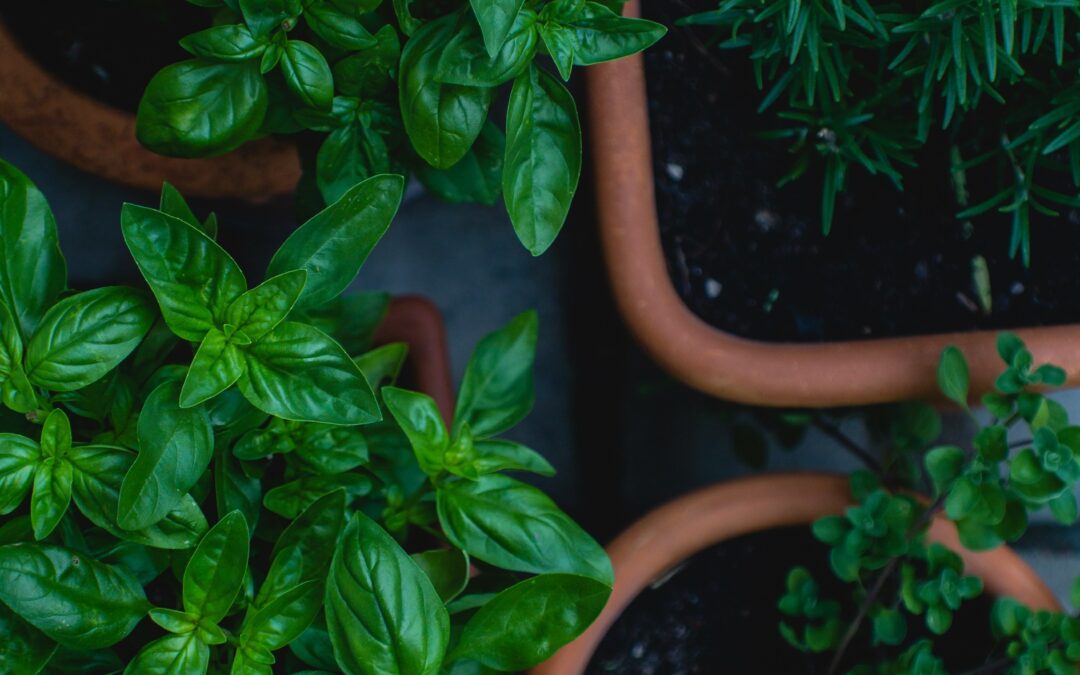There’s nothing nicer – or healthier – than cooking with fresh herbs picked from your own garden. Most are easy to grow and look fab, whether in borders, containers or raised beds. Mediterranean varieties prefer sun and free-draining soil – add coarse grit and organic matter to clay soil. Others, such as coriander, mint and parsley are happy in some shade, with plenty of moisture. Here’s some to try:
Mint.
Great in herbal teas and summer drinks, with roast lamb or in Middle Eastern dishes, mint is a great herb to have in a pot outside the door – it can be invasive in a border. As well as spearmint and peppermint, there are masses of different varieties to try including large woolly-leaved apple mint, lemon mint, pineapple mint, and chocolate mint – nice in puddings! It Iikes rich moist soil and can tolerate shade. Keep picking it to encourage growth and divide it when it’s outgrown the container.
Thyme
An incredibly attractive and useful herb, this is a fab choice for a pot or sunny spot in the border. There are lots of different varieties, from the creeping ‘Thymus serpyllum’ -which is great between stepping stones – to more mound-forming golden T. ‘Bertram Anderson’ and gorgeous variegated T. ‘Silver Queen’. Like most herbs, they respond well to being picked but they have such pretty flowers in pinks and whites that it’s also nice to leave them to flower before pruning again.
Oregano (marjoram)
This spreading herb seems to thrive in the borders in our garden creating mounds of fresh leaves, then in early summer is covered in a mass of pink or purple flowers that attract bees and butterflies. Best harvested before the pretty flowers appear – strip off a few of the leaves for tomato-based dishes such as pasta sauce or Bolognese. I also use oregano in pesto. Lovely varieties to try include O. ‘Herrenhausen’, golden O. ‘Aureum Crispum’ or O. Compactum for smaller gardens.
Sage
This is another drought-tolerant sun lover that hates soggy roots. Sage has lovely silvery leaves and the stunning purple sage which look great in borders with lavenders and other Mediterranean herbs. To keep them compact and avoid them getting leggy, they need a prune in early spring and again after flowering. As well as stuffing, try sage with pork or in sage butter.
Bay
This is a vigorous shrub that can get huge in the ground but can be trained into a ball or lollypop in a pot – it’ll need benefit from a yearly top dressing of mulch and given a monthly feed to keep it green and healthy. Bay leaves – fresh or dried – give a lovely flavour to stocks and soups. (Remove them before you do any blending!)
Rosemary
A must-have herb – rosemary provides the garden with a good evergreen presence and is tasty too – fab with roast lamb and roast veg. It has pretty flowers, varying in intensity, which come early in the season, so are an excellent early bee magnet. It can get big but is easy to prune into a neat shape. R. ‘Benendon Blue’ and ‘Miss Jessopp’s Upright’ has a tall habit whereas creeping prostrate varieties are good hanging over walls. It’s pretty tough and easy to grow but prefers a free-draining soil so add grit to clay soils.
Chives
Chives like sun and well-drained soil, but can grow in heavier soils in partial shade. Lift and divide them every few years. Although the flowers are pretty, snipping off buds will encourage growth. But you can eat the flowers in a salad and cut back the plant to the ground for a second flush. With a similar flavor to garlic and onions, they’ll liven up salads, eggs and cheese dishes.
Fennel
The tall feathery foliage of fennel looks lovely with other perennials in a border and the fab yellow flowers are followed by edible seeds. Bronze fennel (Foeniculum Purpureum) has lovely bronze purple foliage and yellow flowers. Fresh fennel leaves are tasty in salads and with fish and collect the dried seeds to make teas.
Photo by Markus Spiske on Unsplash

